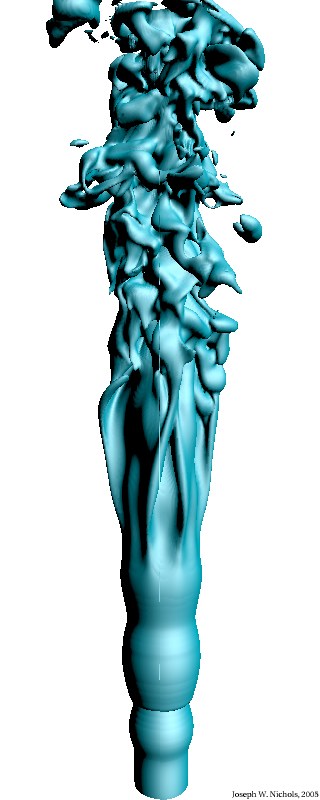Professor Riley's Research on Turbulent, Reacting
Flows
The phenomenon of turbulent, reacting flow plays an important role
in many processes in nature and technology, ranging from the fate of
ozone in the atmosphere, to the properties of gas turbine engines, to
the efficient and clean use of energy. The present capability to
accurately predict these flows is very limited, however, which
inhibits the accurate prediction of environmental effects of
pollutants, and also the design of new combustion devices. The goals
of Professor Riley's research in this area are to better understand
various features of turbulent reacting flows, to test and offer
improvements to existing predictive models, and to develop new models
when appropriate. This work is being carried out mainly in
collaboration with Professor John Kramlich and Research Associate
Oscar Flores, and has involved collaboration with Professor George
Kosály, and former graduate students Andy Cook, Vebjorn Nilsen,
Chris Montgomery, Ruddy Mell, and Steve deBruynKops, Satoshi Mitarai,
Joe Nichols, Saensuk Wetchagarun, Steve Clark, and with current
graduate student Weirong Wang. The research has been supported by the
National Science Foundation, the Gas Research Institute, the Air Force
Office of Scientific Research, and the National Aeronautics and Space
Administration.
Some recent research has focused on the behavior of non-premixed
jet flames, subject to the influence of both buoyancy and external
forcing. The accompanying figure, taken from a simulation carried out
by Joe Nichols of a transitioning jet, shows the instantaneous
behavior of the temperature field in the jet. (The flow is bottom to
top; the fuel jet is introduced into air from a bottom circular
opening.) Nearly axisymmetric near field instabilities are observed
close to the nozzle; farther from the nozzle the jet is seen to break
down three-dimensionally, and the initial stages of turbulence
are observed near the top of the plot.

One of the most promising new methods for predicting turbulent
flows is Large-Eddy Simulation. Significant advances have been made in
the development of this methodology as applied to non-reacting flows.
The application to reacting flows has been much more difficult,
however, due partly to the fact that the chemical reactions often
occur on very small length scales. Working with former graduate
students Andy Cook, Steve deBruynKops, Satoshi Mitarai, and Professor
Kosály, Professor Riley has developed a methodology for
applying Large-Eddy Simulations to reacting turbulent flows, utilizing
the concept of laminar flamelets. This approach appears to have great
potential for use in a wide range of problems.
A sampling of recent publications on turbulent, reacting flows is given
below.
- Cook, A. W., and J. J. Riley. 1996. "Direct numerical simulation
of a turbulent reactive plume on a parallel computer", J.
Comp. Physics, Vol. 129, pp. 263-283.
- Riley, J. J.. 1996. "Numerical simulation of variable-density,
reacting flows", in Computational Fluid Dynamics, M. Lesieur,
P. Comte &J. Zinn-Justin, eds., Elsevier.
- Cook, A. W., J. J. Riley, and G. Kosály. 1997. "A laminar
flamelet approach to subgrid-scale chemistry in turbulent flows",
Comb. Flame, Vol. 109, pp. 332-341.
- deBruynKops, S. M., and J. J. Riley. 1997. "Scalar transport
characteristics of the linear-eddy model", Comb. Flame, Vol. 112,
pp. 253-260.
- Montgomery, C. J., G. Kosály, and J. J.
Riley. 1997. "Direct numerical simulation of turbulent
nonpremixed combustion with multistep hydrogen-oxygen kinetics",
Comb. Flame, Vol. 109, pp. 113-144.
- Cook, A. W., and J. J. Riley. 1997. "Subgrid-scale modeling for
turbulent, reacting flows", Comb. Flame, Vol. 112, pp. 593-606.
- deBruynKops, S. M., and J. J. Riley. 1998. "Direct numerical
simulation of laboratory experiments in isotropic turbulence", Phys.
Fl., Vol. 10(9), pp. 2125-2127.
- Cook, A. W., and J. J. Riley. 1998. "Progress in subgrid-scale
combustion modeling", in Computational Fluid Dynamics Review 1998,
M. Hafez, ed., Wiley.
- deBruynKops, S. M., J. J. Riley, G. Kosály, and
A. W. Cook. 1998. "Investigation of modeling for non-premixed turbulent
combustion", Flow, Turbulence and Combustion, Vol. 60(1),
pp. 105-122.
- Riley, J. J. 1999. "Turbulent Combustion Modeling",
in Transition, Turbulence and Combustion Modeling, (invited
article), A. Hanifi et al., eds., Kluwer Academic.
- deBruynKops, S. M., and J. J. Riley. 2000. "Re-examining the
thermal mixing layer with numerical simulations", Phys. Fluids,
Vol. 12, pp.185-192.
- deBruynKops, S. M., and J. J. Riley. 2001. "Mixing
models for large-eddy simulation of non-premixed turbulent
combustion", J. Fluids Engr.-T. ASME, Vol. 123,
pp. 341-346.
- deBruynKops, S. M., J. J. Riley, and
G. Kosály. 2001. "Direct numerical simulation of reacting
scalar mixing layers", Phys. Fluids, Vol. 13,
pp. 1450-1465.
- deBruynKops, S. M., and J. J. Riley. 2003. "Large-eddy
simulation of a reacting scalar mixing layer with Arrhenius
chemistry", Comp. and Math. with Applns., Vol. 46(4),
pp. 547-569.
- S. M. Martin, J. C. Kramlich, G. Kosály, and
J. J. Riley. 2003. "The premixed conditional moment closure
method applied to idealized lean premixed gas turbine
combustors", ASME J. Engr. Gas Turbines and Power,
Vol. 125, pp. 895-900.
- Mitarai, S., J. J. Riley, and G. Kosály. 2003. "A
Lagrangian study of scalar diffusion in isotropic turbulence with
chemical reaction", Phys. Fluids, Vol. 15, pp. 3856-3866.
- Sripakagorn, P., G. Kosály, and
J. J. Riley. 2004. "Investigation of the influence of the
Reynolds number on extinction and reignition",
Comb. Flame, Vol. 136(3), pp. 351-363.
- Mitarai, S., J. J. Riley, and G. Kosály. 2004. "A
new Lagrangian flamelet model for local flame extingction and
re-ignition" Comb. Flame, Vol. 137(3), pp. 306-319.
- Mitarai, S., J. J. Riley, and
G. Kosály. 2005. "Testing of turbulent mixing models for
Monte-Carlo PDF simulations", Phys. Fluids, Vol. 17(4),
Art. No. 047101.
- Riley, J. J. 2006. "Review of large-eddy simulation of
non-premixed turbulent combustion" J. Fluids Engr.,
Vol. 128(2), pp. 341-376.
- Berrouk, A. S., D. E. Stock, D. Laurence, and
J. J. Riley. 2008. "e;Heavy particle dispersion from a point
source in turbulence pipe flow"e;, Int. J. Multiphase
Flow, Vol. 34(10), pp. 916-923.

